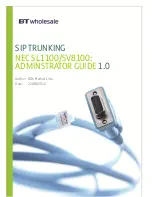
IN STRICTEST CONFIDENCE
BT Wholesale
Issue 1: 2012© British Telecommunications plc
Page 9 of 33
IN STRICTEST CONFIDENCE
3.1
Caveats
Forwarding
When a call is forwarded by a SL1100/SV8100 user/device regardless of whether it has a specific CLID
setup the default CLID for the system is always used in this scenario and therefore is what will be seen
by the destination of the forward.
Toolbar Hold and Call Control
Hold on PBX handset and Toolbar must be used together.
Off System Hold
When a hold request is sent from the IPVS platform to the SL1100/SV8100 and is not followed by an
update for Music On Hold the system will play its own hold music to the local user.
Codec Profiles
The codec profiles offered by the SL1100/SV8100 are predefined meaning the following:
The SL1100/SV8100 only offers one G711 type per profile so we recommend that this is set to A-law.
The G.729_PT profile will offer and therefore allow the use of G711 and G722 meaning that while
G729 is the primary codec it may not be used in all call scenarios.
The G.729_Fix profile will only offer G729 and therefore this will always be used.
T.38 Negotiation
Due to limitations with the current firmware the SL1100/SV8100 is unable initiate the renegotiation
of T.38 for a fax call. If the other party initiates the renegotiation the SL1100/SV8100 will accept this
and T.38 will be used. Where the SL1100/SV8100 attempts to renegotiate to T.38 the fax will
progress using G.711a pass-through with this associated limitations of this method.
Double Hold
Due to limitations with the current firmware if an external party is placed on hold by the
SL1100/SV8100 that party is then unable to in turn place the SL1100/SV8100 user on hold. This
means that any flows involving the SL1100/SV8100 user being placed on hold which include
transferring will fail.
























